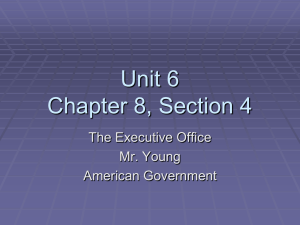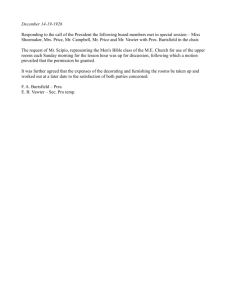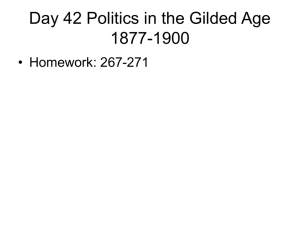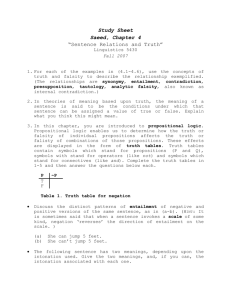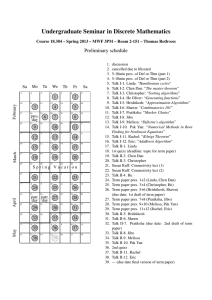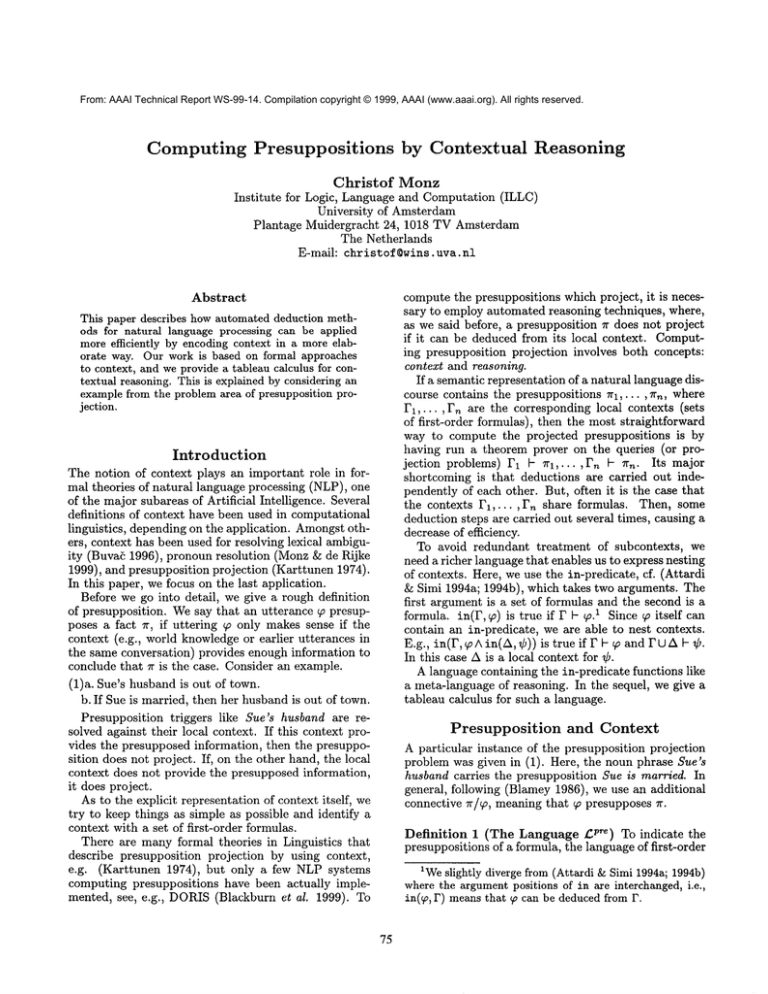
From: AAAI Technical Report WS-99-14. Compilation copyright © 1999, AAAI (www.aaai.org). All rights reserved.
Computing Presuppositions
by Contextual
Reasoning
Christof
Monz
for Logic, Language and Computation (ILLC)
University of Amsterdam
Plantage Muidergracht 24, 1018 TV Amsterdam
The Netherlands
E-mail:christof©wins,
uva.nl
Institute
compute the presuppositions which project, it is necessary to employ automated reasoning techniques, where,
as we said before, a presupposition ~r does not project
if it can be deduced from its local context. Computing presupposition projection involves both concepts:
context and reasoning.
If a semantic representation of a natural language discourse contains the presuppositions ul,... ,r~, where
F1,... ,F~ are the corresponding local contexts (sets
of first-order formulas), then the most straightforward
way to compute the projected presuppositions is by
having run a theorem prover on the queries (or projection problems) F1 b- 7rl,...,F~
t- Irn. Its major
shortcoming is that deductions are carried out independently of each other. But, often it is the case that
the contexts F1,... ,F~ share formulas. Then, some
deduction steps are carried out several times, causing a
decrease of efficiency.
To avoid redundant treatment of subcontexts, we
need a richer language that enables us to express nesting
of contexts. Here, we use the in-predicate, cf. (Attardi
& Simi 1994a; 1994b), which takes two arguments. The
first argument is a set of formulas and the second is a
formula, in(F, ~) is true if F F- ~o.1 Since ~ itself can
contain an in-predicate, we are able to nest contexts.
E.g., in(F, ~ A in(A, ¢)) is true if F t- ~ and F U A }In this case A is a local context for ¢.
A language containing the in-predicate functions like
a meta-language of reasoning. In the sequel, we give a
tableau calculus for such a language.
Abstract
This paper describes how automated deduction methods for natural language processing can be applied
more efficiently by encoding context in a more elaborate way. Our work is based on formal approaches
to context, and we provide a tableau calculus for contextual reasoning. This is explained by considering an
examplefrom the problem area of presupposition projection.
Introduction
The notion of context plays an important role in formal theories of natural language processing (NLP), one
of the major subareas of Artificial Intelligence. Several
definitions of context have been used in computational
linguistics, depending on the application. Amongstothers, context has been used for resolving lexical ambiguity (Buva~ 1996), pronoun resolution (Monz & de Rijke
1999), and presupposition projection (Karttunen 1974).
In this paper, we focus on the last application.
Before we go into detail, we give a rough definition
of presupposition. Wesay that an utterance ~ presupposes a fact It, if uttering ~ only makes sense if the
context (e.g., world knowledgeor earlier utterances in
the same conversation) provides enough information to
conclude that Ir is the case. Consider an example.
(1)a. Sue’s husband is out of town.
b. If Sue is married, then her husband is out of town.
Presupposition triggers like Sue’s husband are resolved against their local context. If this context provides the presupposed information, then the presupposition does not project. If, on the other hand, the local
context does not provide the presupposed information,
it does project.
As to the explicit representation of context itself, we
try to keep things as simple as possible and identify a
context with a set of first-order formulas.
There are many formal theories in Linguistics that
describe presupposition projection by using context,
e.g. (Karttunen 1974), but only a few NLPsystems
computing presuppositions have been actually implemented, see, e.g., DORIS(Blackburn et al. 1999). To
Presupposition
and Context
A particular instance of the presupposition projection
problem was given in (1). Here, the noun phrase Sue’s
husband carries the presupposition Sue is married. In
general, following (Blamey 1986), we use an additional
connective 7r/~, meaning that ~ presupposes ~r.
Definition 1 (The Language £:p~e) To indicate the
presuppositions of a formula, the language of first-order
1Weslightly diverge from (Attardi &Simi 1994a; 1994b)
where the argumentpositions of in axe interchanged, i.e.,
in(~, F) means that ~ can be deduced from
75
To see whythis is the case, let us have a closer look at
the way pres recursively computes the presuppositions.
The contextual parameter of pres is initialized to @, as
there is no further context preceding (2).
pres(~A ((~o/¢ --~ (qo A ¢)/X) °¢p/w))
= pres(qo)0 U pres((qo/¢--+ (qo A ¢)/X) A qo/w)(~) by (iii)
= pres((qo/~b --+ (~o A ¢)/X) A ~o/w){~’}
by (i)
{~’¢}
= pres((~/¢ -+ (~ A ~b)/x)){~} U pres(qo/w)
by (iii)
= pres(~/¢)(~} U pres((~ (~’¢)
A ¢)/X))
{’:’¢--*x)
Upres(~lw)
by (iv)
= pres((~ A ¢)/X)){~’¢} U {~’’¢-+xt
pres(cp/w)
by(viii)
{~’)
where pres(~/¢)
= ~ because {~} l- qo
{’~’¢--*x}
=pres(~lw)
by (viii)
where pres((~ A ¢)/X){~’¢} = 0 because {qo, ¢} l- ~ A ¢
= (~
by (viii)
where pres(~/w)(~’+~×}= O because {~, ¢ -~ X} ~The application of pres to (2) involves three inferences:
{(p} F (p, {(p,¢} F (p A ¢, and {(p, ¢ --+ X}F (p.
the premise (p is used three times and the proving
method has to apply the same set of rules three times
to the same formula. As we mentioned earlier, this
is due to the fact that the contexts (premises) are
considered to be independent of each other. From a
computational point of view, this redundancy is rather
inefficient. Of course, the example is very simple, but
in general, (p could have been arbitrarily complex. In
(2), the sentences containing presuppositions, (2.b)
(2.c), occur in a context consisting of one sentence, viz.
(2.a), but it could have been a muchlarger context.
This reasoning task can be done more efficiently if we
take the flow of contextual information into account;
i.e., the way contexts are nested. To express nesting of
contexts we use a language containing the in-predicate:
predicate logic E is augmentedwith a binary presupposition connective ’/’. Its left argumentis a first-order
formula and its right argument a formula of/:pre.
IW~l 3x~t~/~
where7r E £;.
The set of contexts C is identified with the finite subsets of £.
Above, we sketched how the projected presupposition
of (1) can be computed. (Karttunen 1974) defines
function pres accomplishing this task.
Definition 2 (Presupposition)
The function pres
defined recursively. It takes two arguments: A formula
of~pre and a context F E C, pres : £:pre XC--+ POW(~).
= 0 if ~o is atomic
(i) rpres(~o)
= rpres(~o)
(ii) pres(-%o) r
U pres(¢)
(iii) pres(~oA ¢)r = pres(~o)r ru{as(~)}
ru{as(~’)}
--~ ¢)r = pres(qo)r Upres(¢)
(iv) pres(cp
LJ pres(~b)
(v) pres(q0V ¢)r = pres(~)r ru(’s(’~)}
(vi) rpres(Vxqo)
= rpres(~)
r
= rpres(~)
(vii) pres(3xqo)
~’pres(~)ru{Tr} ifrt/r
(viii) rpres(~r/~)
= r[ pres(q0)
if F t- 7r
The last rule is the one we want to focus on this paper,
because it involves contextuM reasoning.
The function as returns the assertive content of a formula of/:p~e, cf. (Karttunen & Peters 1979). Roughly
speaking, the assertive part of a formula (p E/:pre is obtained by substituting all subformulas of the form 7r/¢
by ¢. The assertive part can be recursively computed
by applying the function as to (p.
Definition 3 (Assertive Content) as is a function
from/~inc to £:
as(R(tl...t~))
R(tl...t~)
as(~)
= ~s(~)
as(qo¯ ¢)
= as(qo) ¯ as(C), where¯ e {A, --+,
as(~/~,)
= as(~,)
as(Qx~o)
= Qxas(~o), where Q e {V,3}
Definition 4 (The Language Z:c°~) £~o,~ is defined
recursively as follows, where F ~ C:
~o ::=
R(tl...t~)l-~ot~oA¢l~o-~¢l~oV¢
IW~l~z~l ~n(r,~) I
Wedo not use/2~°~ to express the semantics of a natural language discourse, but only for expressing which
presupposition triggers have to be evaluated against
which context. The purpose of/:co,~ is to express these
projection problems in a non-redundant fashion.
Let us reconsider example (2). The antecedent
(2.b) contains the presupposition, that John is married, formalized as (p. The context of this presupposition only consists of (2.a), also formalized as (p. This
projection problemcan be stated in/:co~ as in({(p}, (p).
The presupposition of the succedent of (2.b), i.e., John
is married and that his wife has a brother, formalized
as (pAth is evaluated against (2.a) and the antecedent
(2.b): in({qo,¢}, (p A ¢). The two projection problems
can be compactly expressed by a single formula of/:co~:
in({(p}, (p A in({¢}, (p A ¢)). The second in-predicate
is nested under a context where (p already holds, and
it is not necessary to express again that (p holds. The
Let us consider an example. (2) displays an admittedly quite artificial discourse, but we hope that it illustrates the point.
(2)a. John is married. (~o)
b. If John’s wife has a brother, then John hasn’t met
his brother-in-law, yet. ((p/¢ --+ ((p A ¢)/X)
e. John’s wife has quite a few relatives. ((p/w)
The semantic representations of the three sentences are
displayed in parentheses after each sentence and the
presupposition triggers are underlined.
Applying pres to the whole discourse (the conjunction
of (2.a), (2.b), and (2.c)), it correctly computes
presupposition projects:
pres(~o A ((~/¢ -~ (~ A ¢)/X) A ~/w))~
76
last sentence, (2.c), again presupposes ~. Its context
is (2.a) and(2.b), therefore, in({%¢ -+ X},~v)
hold. Putting the three projection problems together,
we get
R(ti...t~) ~’r = T
(3) in({~}, ~ A in({¢}, ~ ^ ¢) A in({¢ -~ X},
Note, that we did not embed the third in-predicate
the second in-predicate, yielding
(~ oin(F,(~)~,0A
cy,r
(¢)~,{as(~,)))
(1)
(2a)
(25)
(~)~,r f (~)~,r if pp(~)
if pp(~) =
=t
in
=
{
(~)~’° A(¢)~’{"(~)}
(¢)~,ru{~}
where¯ ~ {A,--~}
(4) in({~}, ~ A in({¢}, ~ A ¢ A in({¢ --+ X},
This is not possible because ¢ is a local assumption
(context) only accessible within the conditional.
The obvious question is how we get from a semantic
representation in £mT~to a description of the projection problems in £co~. To this end, we define a translation function ~- which takes two arguments: a formula
of £PT~ and a context. Before we can give the formal
definition of T, we have to define howthe potential presuppositions of a formula can be computed.
pp(~) -~ O,F¢ 0 (3a)
if pp(~) ¢ O, F = O (35)
if pp(~o)=
(3c)
(~ov ¢)",~"
in(F,(~o)’~,°A(¢)"{"(~’~)})
if pp(~o)
¢ ~,
= (~)r,0A(¢)r,{as(~,)}
if pp(~)~ 0, = 0 (4b)
if pp(~)= 0
(4c)
(¢)~,ru{~}
in(F, ~r A (~)~’~) if pp(~) # O, F ¢ ~
~’~
ifpp(~)¢0,
F=0 (5b)
~rA(~v)
ifpp(~)=0,
P¢0 (5c)
in(F, cr)
~r
if pp(~p) = 0, F = 0 (5d)
{
Definition 5 (Potential Presupposition) The potential presupposition of a formula ~ E Li~c are all
formulas ~r E L that occur as subformulas of ~v of the
form 7r/¢.
(Qx ~o)~’r ~’r
= xi~(r,
(~o) ~ (~)-,~) ifif pp(~o)
pp(~o)## 0,
0, rF #= 0$ (6b)
(6a)
if pp(~o)=
(6c)
where ~ ~ {V, ~}
pp(R(tl...t~))
pp(~)
= pp(~)
pp(~¯ ¢)
= pp(~)u pp(¢)if ¯ e {A,--%
pp(mr/~) = pp(~)
U{Tr)
pp(Ox~)
= pp(~)if 0 E{7, :l}
Table 1: Translating from £pr~ to £co~
~’~
(~oA((~,/¢--+(~oA¢)/X)
^~o/’,-’))
by (3c):
= ((~/¢ -, (~ A¢)/x) A~/~)’,~
by (3a)
"’~A(~/~)"~+-*~)
= in({~}, (~/¢ -~ (~ ^ ¢)/X)
pp simply collects all presuppositions without checking
whether they are entailed by there local context.
Now,we can define a translation T from Lpr~ to £co~.
The function T is defined in Table 1. Since it is rather
complex and we have only limited space, we just try to
sketch its rationale. T is defined recursively, taking two
parazneters: a formula of Z:p~ and a context F.
by (35):
"’{¢-*x})
’’{x} A (~/w)
= in({~}, (~/¢)~’~ ^ ((~ ¢)IX)
by (5d):
= in({~}, ~ ^ ((~ ^ ¢)/x)~’~"’~+-*~)
^ (~/~)
by (5c):
= in({#}, ~o ^ ia({X}, ~ ^ ¢) A"~’{¢-*×})
(~Plw)
by (5c):
= ia({cp}, ~ A in({X}, ~p A ¢) A ia({~b ~ X},~))
Let X be in £P~. If the main operator is unary and
X contains potential presuppositions, then we proceed
with translating the immediate subformula of X. If X
is of the form ~ A ¢, we check whether ~v contains potential presup~positions. If this is the case, X translates
as in(F, (~)r,~ A (¢)r,{as(~)}). The first argument
is the context and (~)r,O gets 0 as the context, because
the translation of ~ will be embeddedin F by the inpredicate. Similarly for (¢)r,{a,(~)}, but here the
text is augmented by the assertive content of % which
was not available for ~v itself. No in-predicate is introduced if the context parameter is empty. Note that
the way how contexts are augmented, see, for instance,
(¢)~,{"(~)}, follows the definition of pres.
Reconsidering(2), the translation of its semantic repp~
resentation in L
Nowwe have
presupposition
translating it
ing projection
more efficient
defined an algorithmic way to state a
projection problem in a compact way by
to g~o,. The main advantage of expressproblems in £~o, is that it allows for a
way of reasoning; see below.
Contextual Reasoning
In the previous section, we have seen how translating
from £vTo to £~o= can help stating presupposition projection problems in a compact way. In this section, we
provide a tableau calculus for the language £~°~. If
~ £~o~is valid, then all presuppositions are entailed
by their local context and none of them projects.
The most important rule of our tableau calculus ~°’~
T
is the rule (~in). Before we introduce the other rules,
it is helpful to have a closer look at (-~in), in order
n ((~/¢ -+ (~ A ¢)/x) ~/~)
proceeds as follows:
77
understand the way context is represented in
(i, ~): ~in({~:,...,~},¢)
(j, ,~u{i}):
c°~.
T
(in)
(~in)
(i, ~):~:n({vl,...,v,},
(j,~u(i}):v,
(j, ~u{i}):
0, ou{i}):~¢
To keep track of the contextual information, labels are
attached to the nodes in the tableau. A label has two
arguments. Its first argument i is a natural number
(i E IN), which is the identifier of the context. I.e.,
two nodes have the same number as the first argument
of their labels, then they belong to the same context.
The second argument cr is a set of natural numbers.
This set contains the identifiers of the contexts that are
accessible. Wesay that a context F is accessible from
a formula ¢, if there is a formula of the form in(F, ~o)
and ¢ is a subformula of ~o. For instance, considering
the formula in(F, ~o A in(A, ¢)), F is accessible
~o and in(A,¢). Also A is accessible from ¢. Since
accessibility is transitive, it holds that F is accessible
from ¢; but A is not accessible from ~o.
The (--in)-rule
is similar to the upwards direction
Centering a context) of the (CS)-rule in (Buva~ & Mason
1993):
~-~*~1~o
(cs)
F~ ist(~l,~)
represents
a sequence
of contexts
and the upwards
direction
oftherulesaysthatifitistrueinthecontext
that~ holdsin theextension
with~:,then~ holds
inthecontext
~ * ~:itself.
Comparing(CS) to (--in), we can say that ~ corresponds to a U {i} and j, the identifier of the context
extension with {~ol,... , ~,-,¢}, corresponds to ~1.
Table 2 gives the complete set of tableau rules. Besides the rules for the in-predicate, it contains the usual
rule for the boolean connectives and quantifiers. ~ is a
meta-variable over labels of the form (i, a). As the expansion rules for the regular logical connectives do not
change the contextual information, the label of the parent and the label(s) of the daughter(s) are identified.
The contextual information carried by the labels becomes important when we want to define the closure
conditions of a branch.
Definition 6 (Closure of a Branch) A branch of
tableau tree is closed if it contains two nodes of the
form (i, a):~ and (j, a’):--¢ such
(a) ~o and ¢ are unifiable, and
(b) (i) i = j or (ii) i e cr’ or (iii)
(a) is the standard condition on branch closure. (b)
considers three cases. If i = j, then both literals belong
to the same context. If i E at, then ~o belongs to an
extension of j. (iii) is analogous to the previous one.
Again, we consider the projection problem of (2). Applying the tableau expansion rules to the negation of
(3), we try to derive a contradiction (a closed tableau).
(j, ~u{i}):
(j, ~u{i}):
~:--~(~Ol
A ~o2)
(A)
[:~01
[: ~ (~O1 V ~02)
V ~02
[: ~olI ~: ~o2(v)
t: ~01 I ’~:
[: -,qo:A-,~o2
[: Vx~
(~v)
(~)
(-0
(~2
’~:
--
(~A)
~1 A "~
(~)
l:~
(v)
e: ~[~/x]
£: -~Vx
~o
(~v)
£: 3x--~o
&3z ~p
e:~o[~//(x:
... x~)]
(3)
~: -,3x~o
(~)
i: Vx-~
wherefor (in) and (rain): is a f re sh natural number that
does not occur elsewherein the tableau, (V): X is free in qo,
and (B): X~... X~are the free variables in qo.
Table 2: The set of tableaux rules
To verify the negation of the projection problem
in the initial context 0, we create a new context 1,
where the contextual assumptions of the in-predicate
hold, but not the second argument. Both nodes, the
node belonging to the contextual assumption of the
in-predicate and the negation of its second argument,
carry a 1 as its context identifier and have 0 (the context in which the in-predicate occurred) as an element
of the set of accessible contexts. The remaining steps either follow the same pattern or are just regular boolean
tableau expansion rules. The pairs of nodes that allow to close a branch are connected by a dashed line.
(1, {0}):~ and (2, {1,0}):-,qo allow to close the second
branch from the left, because the first node is accessible from the second, as 1 ~ {1, 0}, which is the set of
contexts that are accessible from the second node. The
first and the third branch can be closed because both
nodes belong to the same context. The two right-most
branches can be closed, because 1 is accessible from 3.
An Application to Dialogue Systems
Dialogue systems such as route planning systems, e.g.,
Trindi (Cooper et al. 1999), require that the system
78
(0, @):--, in({~}, ~ A in({O}, ~ A ~) A in({~ --~ X},
I
_ ~_-----(1,{0}):9~
.....
to £co~. In addition, a tableau calculus T~°n has been
presented, which allows to compute presupposition
projection more efficiently
than approaches considering the
projection problems independent of each other.
In this paper, contexts were simply identified
with
sets of first-order
formulas. Our future work will focus
on a more complex representation
of context, as it recently emerged in computational linguistics,
cf. (van der
Sandt 1992). His approach seems to be more appropriate for describing some projection phenomena that cannot be explained within a framework that uses a simple
notion of context like we did. Nevertheless,
we think
that the translation
function and the tableau calculus
are defined generally enough to be adaptable to a more
refined representation of context.
Acknowledgments.
Thanks go to Marco AieUo and
Maarten de Rijke for helpful
comments. The author
was supported by the Physical Sciences Council with
financial support from the Netherlands Organization for
Scientific
Research (NWO), project 612-13-001.
\
\
(1,{o
I
I
(1, {o}):--, (in({¢),~ ^¢) ^in({¢~’))
/
(1, {0}) : -n in({~}, 99 A
I
\
(2,{1,o}):
\\
[
\(2,{1,
(1, {o)):-~in({¢+ X},
I
/
~ {1,o}): ¢ ~x,,
(3,
\
(2,{1,o}):-~(~^ \
/
\
I
(3, {1, 0}):
/
’ (3, {1, 0}) :~¢~~
/
(2, {z, o)):-~¢
(3, {1,o}):x
Figure 1: The tableau for the projection
problem of (2)
References
Attardi, G., and Simi, M. 1994a. Building proofs in context. In Proc. of Meta ’9~, LNCS883, 410-424. Springer.
Attardi, G., and Simi, M. 1994b. Proofs in context. In
Doyle, J., and Torasso, P., eds., Principles of Knowledge
Representation and Reasoning: Proe. of the Fourth International Conference. Morgan Kaufmann.
Blackburn, P.; Bos, 3.; Kohlhase, M.; and de Nivelle, H.
1999. Inference and computational semantics. In Bunt, H.,
and Thijsse, E., eds., 3rd International Workshop on Computational Semantics (IWCS-3), 5-21. Tilburg University.
Blamey, S. 1986. Partial logic. In Gabbay, D., and Guenthner, F., eds., Handbookof Philosophical Logic, volume
III. Kluwer Academic Publishers. 1-70.
Buva~, S., and Mason, I. 1993. Propositional
logic of
context. In Fikes, R., and Lehnert, W., eds., Proceedings of
the Eleventh National Conference on Artificial Intelligence,
412-419. Menlo Park, California: AAAIPress.
Buva~, S. 1996. Resolving lexical ambiguity using a formal
theory of context. In Peters, S., and van Deemter, K., eds.,
Semantic Ambiguity and Underspecification.
CSLI Lecture
Notes. 101-124.
Cooper et al., R. 1999. Coding instructional dialogue for
information states. Deliverable D1.3, Trindi Project.
Karttunen, L., and Peters, S. 1979. Conventional implicatures in Montague Grammar. In Oh, C., and Dineen, D.,
eds., Syntax and Semantics 11: Presupposition. Academic
Press, NewYork. 1-56.
Karttunen, L. 1974. Presupposition and linguistic context.
Theoretical Linguistics 1(1):181-194.
Monz, C., and de Rijke, M. 1999. A tableau calculus for pronoun resolution. In Murray, N., ed., Proc. of
TABLEAUX’99,LNAI. Springer.
Monz, C. 1999. Contextual inference in computational
semantics. Submitted for publication.
van der Sandt, R. 1992. Presupposition
projection
as
anaphora resolution. Journal of Semantics 9:333-377.
can deal with presuppositions.
In dialogues, presuppositions play an important role because it is convenient
to take some things for granted as they have been mentioned before or they are part of common knowledge.
For instance, in the following dialogue, the presupposition trigger my start, assumes that it a start-location
has been mentioned before.
User: I would like to go to Paris.
System: Where do you start?
User: My start is Amsterdam
System: When do you travel?
...
In order to detect whether the user presupposes material
that has not been mentioned in the preceding
discourse and which is not part of the system’s knowledge base, it is necessary that the system can compute
those presuppositions that project. If a presupposition
projects,
the system can get back to the user and ask
him for futher explanations. This way of detecting missing information by using deductive methods is more elegant than simply looking whether a term has occurred
before. The system behaves more intelligent
and has
to ask less questions about things which are obvious
for the user as he has told the system before--although
in other words. In order to improve the acceptability
of dialogue system it is mandatory that the user can
convey information in a convenient and non-redundant
way without having to repeat things.
Although the way context is represented in the Trindi
system differs from our approach, it is possible to adapt
our techniques to the Trindi system, cf. (Monz 1999).
Conclusions
and Future
Work
Computing the presuppositions
of a natural language
discourse is an important task for a natural language
processing system. Employing a language like £co,~ allows for a non-redundant way of stating presupposition
problems. To this end, we gave a translation
from £:pre
79

